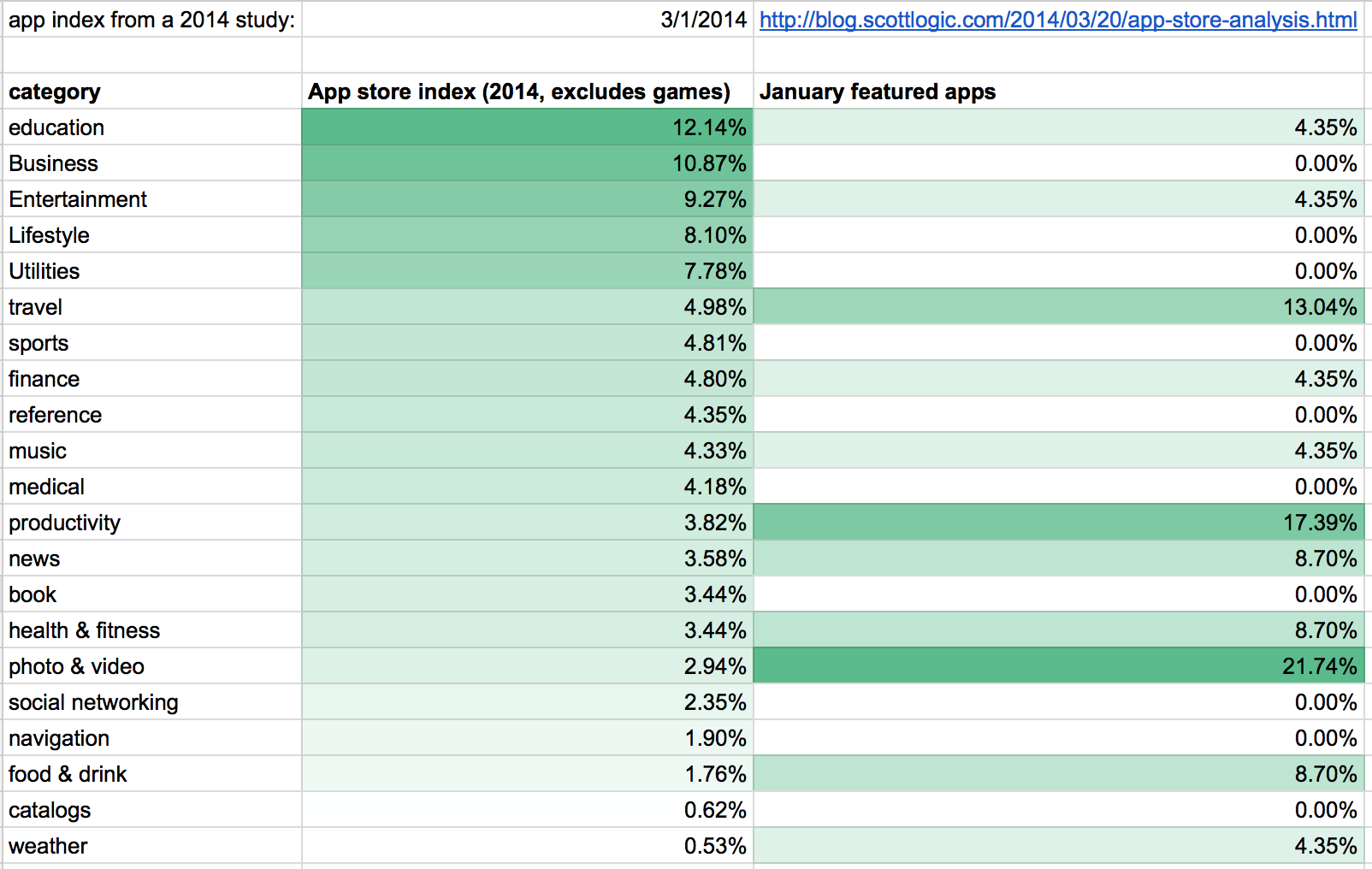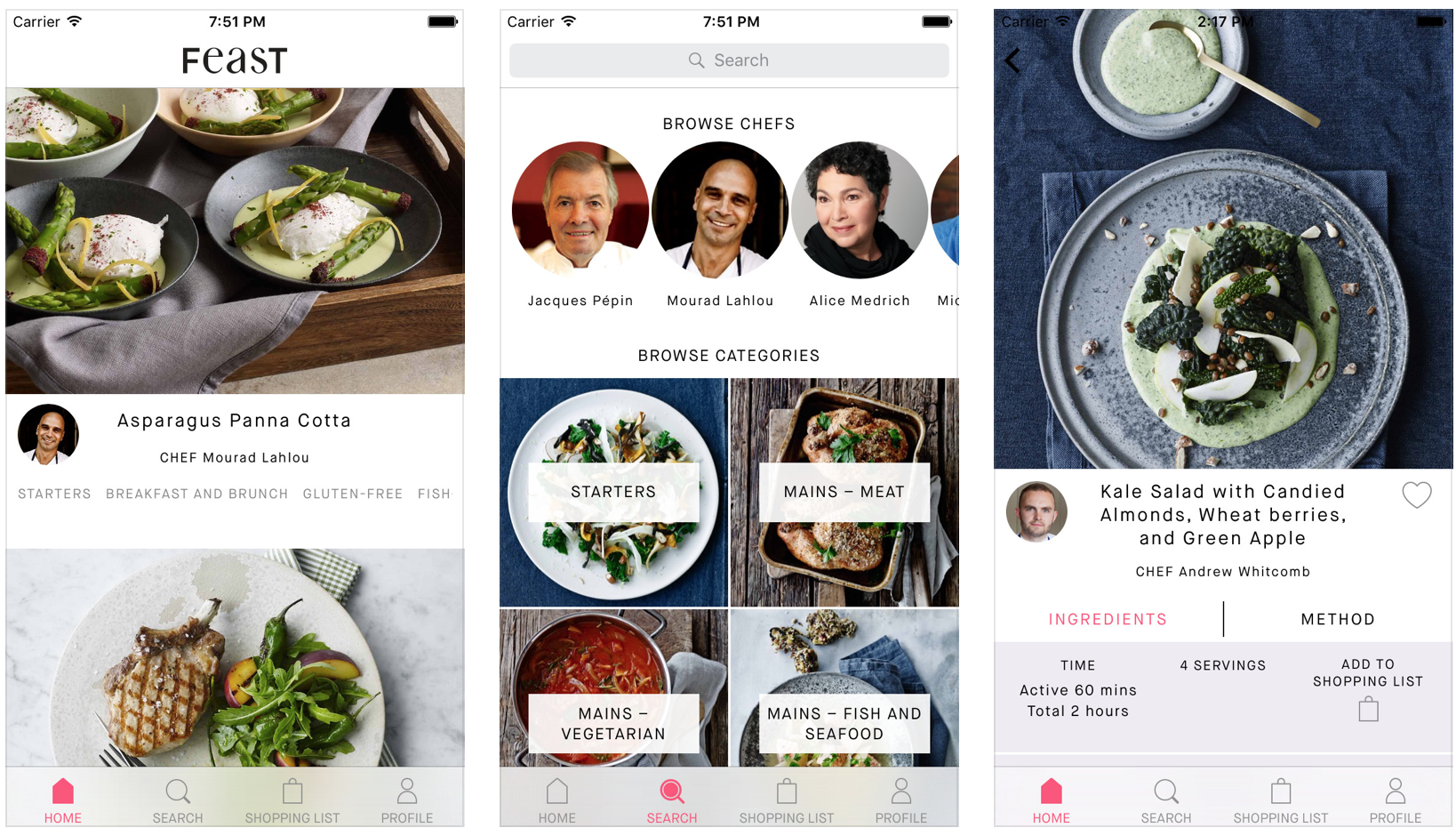Summarized Findings:
TLDNR: we observed the following 5 correlations between featured apps to be some of the strongest:- Apple skews towards featuring apps that are visually stunning and centered around pictures (with a requirement for a great icon to boot), family friendly and also free.
- Apple does feature some apps that solve a need, but moreover focuses on apps that encourage users to be creative, social or to explore the world around them.
- Updating an app with additional functionality or adopting new technology can boost your chances of being featured if you missed out during launch.
- Getting press is vital for being featured, and optimizing your app for multiple languages can drive up your overall visibility.
- Making a universal app can’t hurt but isn’t strongly correlated with being featured.
Section 1: The quantitative look
Of the more than 25 individual data points collected during the study, here were the most noteworthy facts captured about the 23 apps and their developers from the Best of January 2016 list:- One of the more surprising facts was that 52% of featured apps supported onlyiPhone, with less than half (43%) optimized for iPad users as well, and only 9% (two apps) supporting WatchOS.
- The distribution of apps that were featured did not follow the distribution of apps in the app store (2014 app distribution data). Photo and video far over-indexed (22% featured vs 3% total), as did productivity (17 % featured vs 4% total) and travel (13% featured vs 5% total).

- The list is naturally a collection of some of the most well-loved products: these 23 apps racked up a whopping 6,328 features worldwide (App Annie data), with a simple average of 4.6 features per day each app was live. Two apps in particular took the featured cake: Easy Music, at 40.2 and CHOMP, at 24.9 features per day live. 39% of apps were also editor’s choice honorees.
- The simple average rating was 4.3 (minimum 3), with a simple average of 6 ratings per day live.
- Most (65%) of apps were new to the store (launched in December 2015 or later), but 35% were recently updated (Credit Karma was originally launched in 2012). For the updated subset, while a couple had unimpressive updates compared to their version history, most included an extension to their technology:
- 3 of 8 added 3D touch functionality and another added 3D touch in February.
- 2 of 8 added support for additional device types.
- On average, each developer had released 8.3 total apps (43% had only 1 app in their developer account and only 39% of apps were made by public companies or funded startups).
- 74% of featured apps were free
- The apps were highly kid and family friendly: 65% of apps were suitable for ages 4+
- iOS 8.0 was the most common minimum supported OS (48%); only 22% of apps were optimized for an OS earlier than 8.0
- These apps supported a simple average of 7 languages, but near half (43%) supported only English
- Size didn’t matter: the apps were an average of 68 megabytes, topping out at 262 (Easy Music)
- Regarding the social presence of the developer (or the app if there was no developer account):
- the average Instagram following was 266,549.
- the average Twitter following was 567,120.
- the average Facebook following was 781,708.

Section 2: The qualitative look
Reading beyond the surface-level data points, here were some additional findings that we uncovered about why Apple chooses to feature apps. The qualitative analysis also includes some perspective from a couple teams whose apps were featured (Wild Weather and Feast Kitchen) and whom I had the pleasure to speak with:- Naturally, all apps had a visually appealing icon as well as great UI design. Being a good looking app is so important that, in a sense it put very simple apps like Old Sport on equal footing (that is: featured for January) with other apps that pushed the limits of technology like MSQRD or Concepts. This indicates that finding the right UI designer is one of the most important decisions an app team can make. Even the fact that a few of the beautiful apps still had bugs underscores the overwhelming importance of UI design to Apple. The only design exception was REI, which did not mimic Apple aesthetic, but did make prodigious use of big images (though the REI app’s “rustic” look is on brand with REI’s style). This need to focus on creating an excellent visual experience in the app was also a common sentiment from the app developers I talked to.
- 52% of apps made social a central component of the app’s existence (above and beyond just being able to share via social networks)
- Taking user feedback and research into account was also a core focus of the interviewed app developers. Mark Hendriks of Wild Weather commented, “We didn’t get featured till the 1.5 update, which was released a month after the first version. You need to show that you move fast and release often: address user feedback, specifically the most important feedback and make it more feature-complete. Your app also has to be unique to some extent. We made some very clear decisions early on, limiting functionality and focusing on the experience; it’s not for everyone and that’s a good thing. We spent a lot of time on getting the illustrations and animated weather conditions right. It’s based on simple gestures to not distract from the illustrations.”
- Apple seems to value fun, cultural and humanistic influences over solving a need. Only 22% solved a need (e.g. credit karma), whereas 45% helped users to exercise creativity (e.g. Flowstate), 17% were just plain fun (e.g. Microsoft Selfie) and 17% encouraged users to physically interact with the world around them (e.g. the Outbound).
- 30% provided curated content to users, with nearly all providing at least an option for (if not entirely focused on) content sourced by experts.

- While some members of January featured app teams had worked on apps that were previously featured, others did not; but securing press for their latest app when launching seemed to be a critical component helping push the cause to be featured, as well as being featured in other, smaller features of the app store before being exhibited for a bigger featured post such as the monthly apps list.
Section 3: Closing thoughts
Lastly, we took a look at some of the other featured app listings and observed a few additional ways that app are chosen to be featured:- Utilize a newly released technology by Apple (e.g. WatchOS, 3D touch, Apple pay)
- Create an app that helps a particular niche of users where your peers are other feature-worthy apps (e.g. apps for learning music, apps for teachers, apps for dates)
- Create apps relevant for trending topics (e.g. Winter, tax season, Carnaval in Brazil)
That’s all for today, folks. Thank you for reading along and thank you Wild Weather and Feast Kitchen teams for the comments!
We are happy to field questions, comments, concerns, future topics or even share the rest of our data with you – just email us! hello@incipia.co
Incipia is a full stack mobile agency – we design, develop and market mobile apps for startups and corporations. Visit Incipia for more information.